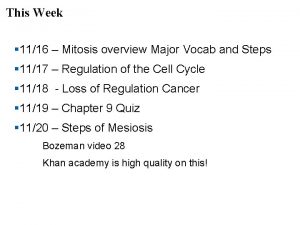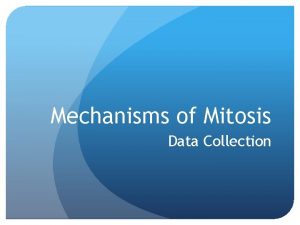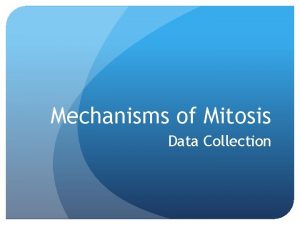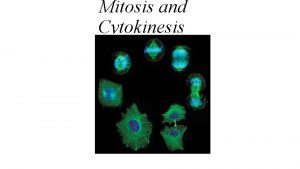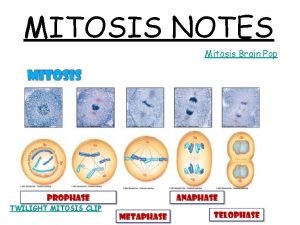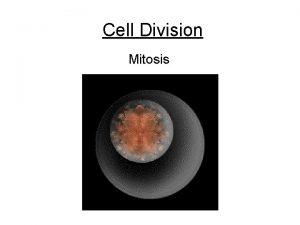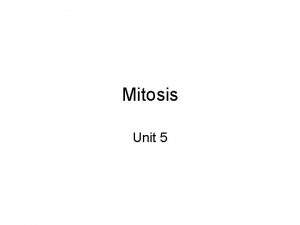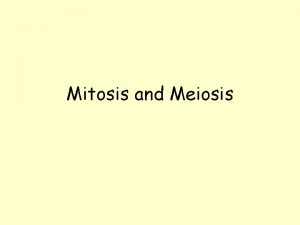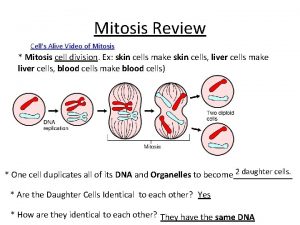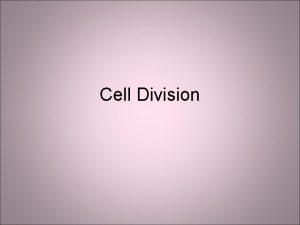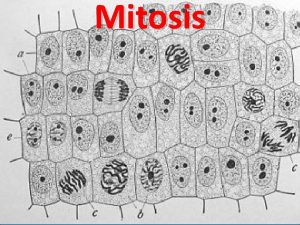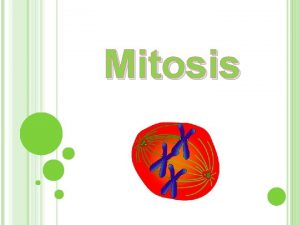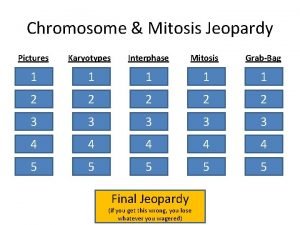Mechanisms of Mitosis Data Collection Data Collection Today





















- Slides: 21

Mechanisms of Mitosis Data Collection

Data Collection Today Group A will collect data from Four untreated control onions Next week, Group B will collect data from Four untreated control onions These will comprise eight control samples.

Treatment vs. Control Between now and next week, your team may choose to meet Via Zoom and/or In person, with proper safety protocols to design a simple experiment

Treatment vs. Control Your experimental protocol is due at the beginning of Session 3 B. Based on your project design, you will be provided with micrographs from 8 treatment root tips.

Data Collection By now you should be able to recognize root tip cells in the different stages of mitosis. Root tips vary in size and quality Count cells in areas where they are clear and not layered.

Data Collection You should count cells in FOUR different fields of view for each root tip. For each field of view, record Total number of cells Number of cells in each stage of mitosis

Data Collection AVOID PSEUDOREPLICATION. Do not take more than one root from the same onion. Do not count multiple fields of view from the same root tip as separate samples. All cells counted from an indivdual onion count as one sample/replicate.

Data Collection Your lab instructor will provide you with an entire root from a particular onion labeled with an identification code (e. g. , C 1, C 2, etc. ) With a lab marker, write the onion’s ID code on the microscope slide you use for its root tip. This will help you keep track of your replicates detect any problems with a particular onion

Data Collection When you are completely finished with a slide preparation, place it in the Broken Glass Disposal Container at the front of the lab room. Teams leaving slides at their station or on microscope stage will be docked 5 points.

Data Analysis: Mitotic Index The Mitotic Index (M) represents the proportion/frequency of mitotic cells in your cell population. M = nm/N nm = the number of mitotic cells in the sample (i. e. , those not in interphase) N = the total number of cells counted in the sample.

Data Analysis: Mitotic Index Why might it be useful to compare mitotic indices between treatment and control groups?

Data Analysis: Mitotic Phase Index A Mitotic Phase Index (MP) can be calculated for each mitotic phase you encounter. For example: MP = np/nm np = the number of mitotic cells in prophase in the sample nm = the total number of mitotic cells in the sample

Data Analysis: Mitotic Index Why might it be useful to compare mitotic phase indices between treatment and control groups? Do you need to compare all phases between treatment and control? Which phases would be most useful to compare, given your hypothesis?

Data Analysis: Mitotic Index Before you leave lab today, calculate mitotic indices for each of your control samples. Enter them in a table. Table templates are linked in the syllabus.

Example of Tabulated Indices Sample # (from one onion) Treatment (mitotic index ) Control (mitotic index) 1 0. 20 0. 55 2 0. 25 3 0. 45 0. 60 0. 65 4 0. 35 0. 80 5 0. 15 0. 35 6 0. 10 0. 75 7 0. 55 0. 70 8 0. 40 0. 85 9 0. 30 0. 90 10 0. 45 0. 50

Data Analysis: Mitotic Phase Index Decide which Mitotic Phase Indices (MP) to use for control and treatment comparison… Prophase Metaphase Anaphase Telophase Interphase Tabulate your indices in the table templates provided (linked in the syllabus).

Example: Metaphase Mitotic Phase Index Sample # (from one onion) Treatment (MP for cells in prophase) Control (MP for cells in prophase) 1 0. 20 0. 55 2 0. 25 3 0. 45 0. 60 0. 65 4 0. 35 0. 80 5 0. 15 0. 35 6 0. 10 0. 75 7 0. 55 0. 70 8 0. 40 0. 85 9 0. 30 0. 90 10 0. 45 0. 50

Your Indices are Your Data Mitotic Indices and Mitotic Phase Indices of treatment samples control samples …are the data you will statistically analyze with a Mann-Whitney U test once all your data are collected.

Your Indices are Your Data Make sure all team members (Group A and Group B) have access to a copy of the team’s index calculations before leaving lab.

Your Indices are Your Data Your Homework between Session 3 B and Session 4 will be statistical analysis of your data to see if there is a difference between your treatment and control groups.

Questions?
 Non kinetochore microtubules
Non kinetochore microtubules For today's meeting
For today's meeting Today's classes
Today's classes Meeting objective
Meeting objective Characteristic of fingerprint
Characteristic of fingerprint Today's lesson or today lesson
Today's lesson or today lesson Today's lesson or today lesson
Today's lesson or today lesson Landsat collection 1 vs collection 2
Landsat collection 1 vs collection 2 Documentary payment
Documentary payment Data collection procedure
Data collection procedure Data collection secondary data sources
Data collection secondary data sources Mechanisms of movement lab report
Mechanisms of movement lab report Virtualization ppt
Virtualization ppt Mom boy
Mom boy What animals are cold blooded
What animals are cold blooded Evaporation heat loss newborn
Evaporation heat loss newborn Regression defense mechanism example
Regression defense mechanism example Th and tc cells
Th and tc cells Reciprocal determinism
Reciprocal determinism Structures and mechanisms
Structures and mechanisms How do sponges protect themselves from predators
How do sponges protect themselves from predators Automated scaling listener
Automated scaling listener
